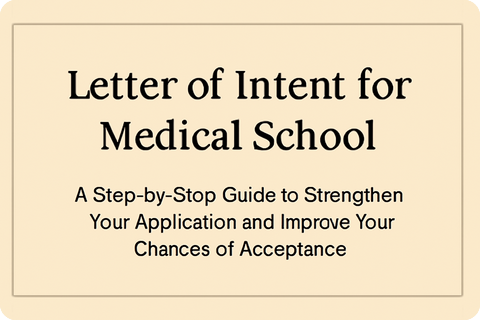Letter of Intent Medical School: A Guide to Crafting the Perfect Application Letter
Master the art of writing a letter of intent for medical school admissions and improve your chances of acceptance.

Introduction to the Medical School Letter of Intent
A letter of intent (LOI) for medical school is one of the most crucial elements of your application, especially if you are waitlisted or applying to your top-choice school. It is a formal letter sent to the admissions committee expressing your strong desire to attend the school if offered a spot. Crafting the perfect medical school letter of intent requires careful thought and professionalism. This article explores the importance of this letter, how to structure it, and best practices to ensure that your letter stands out.
What Is a Letter of Intent for Medical School?
A letter of intent medical school is a formal communication expressing your intent to enroll at a particular medical school if offered admission. It conveys enthusiasm and shows the admissions committee that you are serious about attending their program. Unlike a typical application letter, an LOI is often sent after an interview or when you are waitlisted, as a way to reinforce your commitment.
Why Is the Letter of Intent Important?
A well-crafted medical school letter of intent can make a significant difference in your application process. If you are waitlisted, a letter of intent shows that you remain interested and are willing to enroll if given the opportunity. For schools with a rolling admissions process, sending a letter of intent admissions can help distinguish you from other candidates.
The letter provides a chance to reaffirm why you believe you are a perfect fit for the program, thus strengthening your application and highlighting your readiness. It also demonstrates your professionalism and attention to detail.
How to Structure Your Letter of Intent for Medical School
Writing a letter of intent for medical school requires following specific formatting guidelines. Here is how to structure it:
1. Formal Letter Format
Your LOI medical school should follow the traditional letter format:
-
Date: Write the date at the top of your letter.
-
Admissions Address: Include the admissions office’s address at the top.
-
Salutation: Address the recipient respectfully (e.g., “Dear Dr. [Name],”).
2. Introduction
Start by thanking the admissions committee for the opportunity to interview or be considered. Express enthusiasm about the possibility of attending the school and briefly mention the date of your interview.
Example:
“I am extremely grateful for the opportunity to interview at [Medical School Name] on [Date]. After careful consideration, I am excited to formally express my intent to attend if offered admission.”
3. Statement of Intent
Clearly state that the school is your top choice. If applicable, mention any specific reasons that make this school your preferred option. This is your chance to show the committee that you’ve done your research and are sincerely invested in the program.
Example:
“I am writing to confirm that [Medical School Name] is my top choice, and if offered a position, I will accept it without hesitation.”
4. Fit with the Program
Discuss why you feel you are a strong fit for the program. Highlight specific aspects of the school that align with your academic and professional goals. Mention any conversations with faculty, current students, or specific opportunities the school offers that excite you.
Example:
“The comprehensive clinical training offered at [Medical School Name] and the emphasis on global health initiatives align perfectly with my goals of becoming a well-rounded physician who can serve underserved communities.”
5. Updates and Achievements
If you’ve had any accomplishments since your interview, share them here. This could include awards, research publications, volunteer experiences, or leadership roles. Make sure to connect these achievements to your readiness for medical school.
Example:
“Since our interview, I have had the opportunity to contribute to a research project on [Topic], which has deepened my understanding of [Related Field]. I believe this experience further strengthens my qualifications as a candidate for your program.”
6. Closing
Reaffirm your commitment to attend if admitted and express gratitude. Close the letter with a polite sign-off, such as “Sincerely” or “Best regards,” followed by your full name.
Example:
“Thank you for your time and consideration. I look forward to the possibility of joining the [Medical School Name] community.”
Best Practices for Writing Your Letter of Intent
When writing your letter of intent admissions, follow these best practices:
-
Be Clear and Concise: Keep your letter to one page. A long, drawn-out letter can overwhelm the reader.
-
Use Professional Tone: Your LOI medical school should have a formal, respectful tone. Avoid overly casual language.
-
Personalize the Letter: Avoid generic language. Tailor your letter to the specific medical school, mentioning their unique attributes and programs.
-
Proofread: Ensure that your letter is free from errors. Grammatical accuracy and proper formatting are crucial for presenting yourself as a detail-oriented applicant.
FAQs About the Letter of Intent for Medical School
1. How soon should I send my letter of intent?
It’s recommended to send your letter of intent medical school after your interview or when you are waitlisted, but before the school’s official decision deadline. Make sure to check the school’s timeline.
2. Can I send a letter of intent to multiple schools?
No, sending letters of intent admissions to multiple schools can come off as insincere. It’s best to only send a letter to your top-choice school.
3. What is the difference between a letter of intent and a letter of interest?
A letter of interest is typically less formal and may be sent early in the application process, expressing general interest in the program. A letter of intent is stronger, expressing your clear intention to attend if admitted.
4. How long should my letter of intent be?
Your letter of intent admissions should be no longer than one page. Aim for clear, concise writing to make a strong impression.
Conclusion
Crafting a thoughtful letter of intent for medical school can set you apart in a competitive admissions process. By clearly expressing your commitment to a particular school, reaffirming your fit with their program, and demonstrating ongoing academic and professional growth, you can strengthen your candidacy. Use this guide to help structure your letter and ensure that your application stands out to the admissions committee. Remember, this is your opportunity to show your passion, professionalism, and dedication to becoming a physician.
By following these guidelines and using the related keywords such as medical school application, admissions essay, and secondary application, your letter can make a lasting impact.



